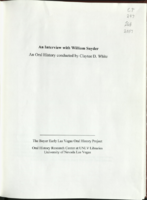Search the Special Collections and Archives Portal
Search Results
Walter Zick oral history interview
Identifier
Abstract
Oral history interview with Walter Zick conducted by Maureen Kelly Ryan on February 22, 1977 for the Ralph Roske Oral History Project on Early Las Vegas. Zick discusses architecture and moving to Las Vegas, Nevada to work at the Basic Magnesium Plant.
Archival Collection
Judy and Harry Campbell oral history interview
Identifier
Abstract
Oral history interview with Judy and Harry Campbell conducted by Stefani Evans and Claytee D. White on October 04, 2016 for the Building Las Vegas Oral History Project. In this interview, Judy discusses her early life in St. John’s, Newfoundland and her move to Ottawa, Canada. Harry discusses his upbringing in Ogden, Utah and his initial interests in architecture. He recalls moving to Las Vegas, Nevada to work for architect Julius Gabriel, construction planning for the Four Queens, and planning for the home of Jerry Mack. Later, Judy talks about her move to Boulder City, Nevada in 1974, her involvement in interior design, and her initial interests in residential real estate. Later, Harry recalls his work with the construction planning of federal court rooms, working with Las Vegas architects, and the process of becoming a licensed architect. Lastly, Judy and Harry talk about the development of Lake Las Vegas.
Archival Collection
Lucile Spire Bruner oral history interview
Identifier
Abstract
Oral history interview with Lucile Spire Bruner conducted by Alice Cowles Brown on March 03, 1977 for the Ralph Roske Oral History Project on Early Las Vegas. Spire Bruner discusses her husband Elmo Bruner's career as an architect and appraiser in Las Vegas, Nevada from, 1947 to 1973, World War II, her religious affiliation with the Unitarian Fellowship Church, and her involvement with organizations such as American Institute of Architects, engineering societies and architectural registration and examination boards.
Archival Collection
Jerde Partnership Records
Identifier
Abstract
The Jerde Partnership Records (1992) is comprised of architectural planning documents used for designing the Fremont Street Experience and Treasure Island Hotel and Casino in Las Vegas, Nevada. Design records for the Fremont Street Experience include concept proposals, sketches, notes, brochures, and a presentation book. Also included are copies of handwritten design notes and sketches and a drawing schedule for the Treasure Island Hotel and Casino.
Archival Collection
DeRuyter Butler oral history interview
Identifier
Abstract
Oral history interview with DeRuyter O. Butler conducted by Stefani Evans and Claytee D. White on September 15, 2016 for the Building Las Vegas Oral History Project. Butler begins with discussing his early life and joining Steve Wynn's Atlandia Design in Atlantic City, New Jersey in 1982. He then talks about moving to Las Vegas, Nevada in 1986. The interview focuses on the design and development of various Las Vegas casinos.
Archival Collection
Paul Steelman oral history interview
Identifier
Abstract
Oral history interview with Paul Steelman conducted by Claytee D. White and Stefani Evans on August 24, 2016 for the Building Las Vegas Oral History Project. In this interview, Steelman discusses his early life and initial interests in architecture. He talks about arriving to Las Vegas, Nevada in 1987, working with architect Joel Bergman, and designing the Mirage with Steve Wynn. Steelman remembers opening up his architecture firm, Steelman Partners LLP, and the properties they have built in Las Vegas.
Archival Collection
Joy Rineer oral history interview
Identifier
Abstract
Oral history interview with Joy Rineer conducted by Claytee D. White on December 07, 2017 for the Remembering 1 October Oral History Project. In this interview, Rineer discusses her upbringing in Las Vegas, Nevada. She describes her career as an architect, designing the Resilience Center for those affected by the 1 October shooting, and the city’s response to the shooting. Later, Rineer describes helping the grief-stricken city through architecture, establishing the Leadership Las Vegas program, and organizing blood drives. Lastly, Rineer discusses the changes in Las Vegas after the tragedy.
Archival Collection
George Tate oral history interview
Identifier
Abstract
Oral history interview with George Tate conducted by Randi Levine and June Brown on September 24, 2002 as part of the UNLV University Libraries Oral History Collection. In this interview, Tate discusses his personal history, his occupation as an architect, and his experience in the United States Army Corps of Engineers. He explains why ground water was an issue for building infrastructure in Las Vegas, Nevada. Lastly, Tate discusses the changes in the professional architectural community, the increase of women in the architectural field, and the competitive aspect of being an architect.
Archival Collection

Transcript of interview with Paul Senzaki, Alan Hess, and Charlie White III by Stefani Evans and Claytee White, September 9, 2016
Date
Archival Collection
Description
Architect Paul Senzaki, and artist-illustrator Charlie White III recall their experiences of working in Las Vegas: Paul on Treasure Island, The Palms, Fremont Street Experience, and World Market Center and Charlie on Treasure Island and its successor, TI; New York New York. Architectural historian Alan Hess, who is an expert on Las Vegas architecture, offers historical context and asks pertinent questions. While this interview touches on several iconic Las Vegas buildings, the conversation mostly details why and how Steve Wynn's Treasure Island involved the labors of artists, illustrators, art directors, and designers of stage and screen as well as the those of architects, contractors, planners, and subcontractors.
Text

Transcript of interview with Bill Snyder by Claytee White, November 21, 2008
Date
Archival Collection
Description
In 1978 Bill Snyder came Las Vegas for a heavyweight championship fight between his homeboy, Larry Holmes and Ken Norton. During that visit, he saw cranes dotting the cityscape so he returned home and proposed that the family move across country and settle in the desert. His wife, Joy, gave him a year. And as they say, the rest is history. And what am amazing history it is. In this interview, Bill Snyder talks about his life from its beginning in Easton, Pennsylvania, where he discovered the challenge of architecture first by perusing books in the library and then by hands-on construction experience. But his love of art built the foundation to this treasured craft that has allowed him to design homes, office buildings, airport terminals and the McCaw School of Mines on the campus of McCaw Elementary School in Henderson, NV. The projects that Mr. Snyder seems to prize most are those that include the imagination of children. The people who shaped his life are introduced and the impact of his military training is wonderfully expressed. His connection with young people is paramount throughout the oral history that is beautifully documented with images of many of the projects that displayed children's art in an exciting way. Bill and Joy are the parents of two sons. Dana age 36, lives with his wife Christine in Hollywood, California, and works as a voice actor best known for his role as Master Shake on the cartoon Aqua Teen Hunger Force. Their younger son, Mike age 31, owns The Krate, a clothing, music, and art shop in Santa Cruz, California, where he lives with his wife Mandy and daughter Maya. A husband, father, sports car enthusiast, runner, thinker and lover of teaching and trusting young people, Bill Snyder is a brilliant architect and manager of people. He is dyslectic and never expected a school to be named in his honor but the William E. Snyder Elementary School was dedicated in 2001 with overwhelming community support. One of his current goals is to dream an architectural project that rivals the McCaw School of Mines for his own school. I trust that you will learn to love architecture in a different and very profound way as you read this interview just as I did during my conversation with Bill.
Text
